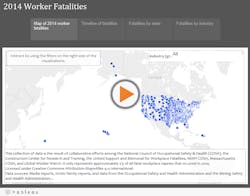4,585.
In 2013, 4,585 people died on the job because of unsafe working conditions.
That number, while much lower than in 1970 when the Occupational Safety and Health Act was passed, is a stark reminder of the work to be done for workers’ safety.
“It’s 4,585 too many men and women who lost their lives trying to earn a paycheck. It’s 4,585 too many workers – mothers and fathers, daughters and sons, sisters and brothers – who went to work but never came home,” U.S. Secretary of Labor Thomas E. Perez said in a statement.
Every year, safety organizations around the U.S. mark April 28 as Workers Memorial Day – a day to pay tribute to those who lost their lives on the job, a day to acknowledge their untimely sacrifice, and a day to vow to do better and create meaningful change.
This year, those same groups collaborated to create an online database of workplace fatalities – the U.S. Worker Fatality Database. The database, which continues to be updated, has information on more than 1,780 workplace fatalities from 2014.
2015 marks the five-year anniversary of three major workplace tragedies –the Deepwater Horizon oil spill, the Upper Big Branch mine disaster and the Tesoro refinery explosion – that left a total of 47 workers dead.
And those tragedies continue to take new forms each year, as new industries and risks emerge.
There certainly are major episodic events like in 2014 when healthcare workers were faced with the Ebola outbreak. But, even more, the workplace safety conversation continues to change as the mobile workplace develops, green jobs are created and hydraulic fracturing (fracking) surges.
“This Workers Memorial Day, while we pay homage to those who have been hurt or killed on the job, we must also rededicate ourselves to producing the knowledge and solutions that are vital to reducing risks of injury among the America’s workforce until the number of deaths are zero,” Director National Institute for Occupational Safety and Health Director John Howard said in a statement.
About the Author
Ginger Christ
Associate Editor
Ginger Christ is an associate editor for EHS Today, a Penton publication.
She has covered business news for the past seven years, working at daily and weekly newspapers and magazines in Ohio, including the Dayton Business Journal and Crain’s Cleveland Business.
Most recently, she covered transportation and leadership for IndustryWeek, a sister publication to EHS Today.
She holds a bachelor of arts in English and in Film Studies from the University of Pittsburgh.

